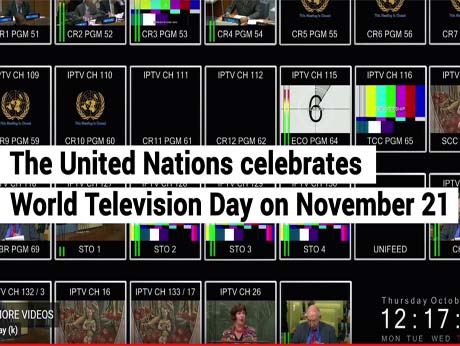
Geneva, November 20 2019: World Television Day, marked globally on 21 November, recognizes the medium as a major source of news, information, education and entertainment. As television broadcasting increases its footprint globally, streaming onto multiple portable devices, TV has become an integral part of life, accounting for 80 per cent of all consumer Internet traffic.
ITU, since it first released technical standards for television 70 years ago in 1949, has developed the globally harmonized standards that have progressively enhanced television viewing experience in terms of both visual and audio quality. From early standards for colour TV to developing parameters for 4:3 and widescreen 16:9 aspect ratio television, ITU has championed the switch to digital TV broadcasting and High Definition Television (HDTV), enabling more services, better picture quality and improved coverage owing to an increase in transmitted bandwidth capacity. Building further on the superior colour fidelity of ITU's Ultra-High Definition Television (UHDTV), ITU introduced High Dynamic Range Television (HDR-TV) bringing increased realism to images.
As 5G services complying with ITU's IMT-2020 spectrum allocations and standards (currently being addressed by the ITU World Radiocommunication Conference in Sharm El-Sheikh, Egypt) are progressively rolled out over the coming years, the convergence of traditional broadcasting and Internet services could lead to the further merging of media content, data, and applications using broadband networks delivered over a combination of terrestrial, satellite and Internet platforms. These "Global Platforms" may one day facilitate delivery of content to end-users on a wide range of devices and receiving platforms, using both broadcasting and non-broadcasting technologies.
ITU and United Nations Television (UNTV) recently interviewed David Wood of the European Broadcasting Union (EBU) for insights into new trends and directions on the future of TV broadcasting. ( see our Tech video on the home page for a few days)
"Television plays a crucial role in connecting the world to information and knowledge while providing an unsurpassed channel for mass entertainment," said ITU Secretary-General Houlin Zhao. "World TV Day brings attention to ITU's exemplary work in producing the standards that are driving future trends in broadcasting and Internet services that will bring an increasingly immersive experience to viewers around the world."
"More than ever, television today provides information, news and entertainment to people wherever they may be," said Mr Mario Maniewicz, Director of the ITU Radiocommunication Bureau. "World TV Day focuses on the work of ITU over the last 70 years in developing new standards and systems for broadcasting, bringing them in line with the latest cutting edge technologies designed to make high quality television coverage available in affordable ways to people in the remotest areas of the world."
In 2012, ITU received the Emmy Award from the US National Academy of Television Arts & Sciences for the "Standardization of Loudness Metering for Use in Broadcast Audio" to balance the loudness within and between broadcast programmes.
ITU's standards for video coding in collaboration with ISO and IEC also received two Primetime Emmy Awards from the Academy of Television Arts & Sciences, the first in 2008 for ITU H.264 | MPEG-4 Advanced Video Coding (AVC) and the second in 2017 for High Efficiency Video Coding (HEVC, published as ITU H.265 | ISO/IEC 23008-2). The Versatile Video Coding (VVC) project, now on course for completion by mid-2020, aims to provide significant improvements, saving up to 37.7 per cent in compression performance over HEVC.
The recently concluded ITU World Radiocommunication Assembly (22-25 October 2019) called for a roadmap on broadcasting concerning audio visual quality assessment and accessibility, audio and video coding, integrated broadcast-broadband, multimedia, and other emerging technologies and applications. The Assembly also sought to promote accessibility for persons with disabilities and specific needs. Subtitles and audio channels describing action in the image, assist the visually impaired while the ability to separate foreground and background sound allows audio to be more intelligible to those with hearing disabilities. ITU has assisted a number of developing countries in transitioning from analogue broadcasting to far more efficient digital broadcasting, enabling people in remotest areas to take advantage of the benefits from digital broadcast technology.
The ITU World Radiocommunication Conference in Sharm El-Sheikh, currently in session from 28 October until 22 November, is addressing requirements for some of the leading edge technological innovations. These include identifying additional frequency bands for International Mobile Telecommunications (IMT), further enabling the rollout of IMT-2020 networks, as well as for High-Altitude Platform Stations (HAPS) – aircraft positioned in the stratosphere for very-long-duration flights used for telecommunications, new non-geostationary satellite systems composed of multiple, multi-satellite constellations, and earth stations in motion (ESIM) communicating from aircraft, maritime vessels and land vehicles with satellites in the geostationary orbit (GSO) using Ka bands.
WHAT IS TV ANYMORE? See our Image of the Day